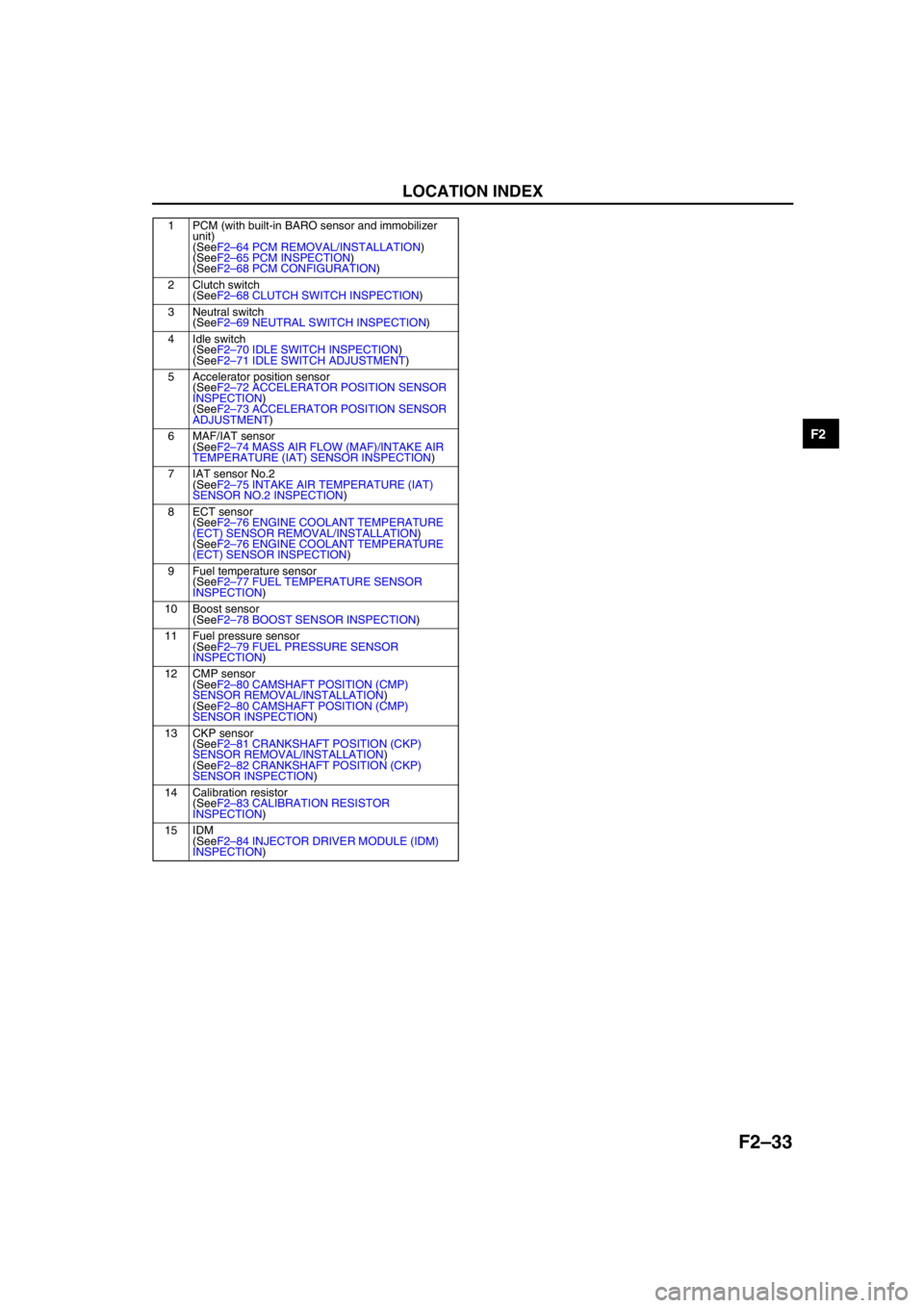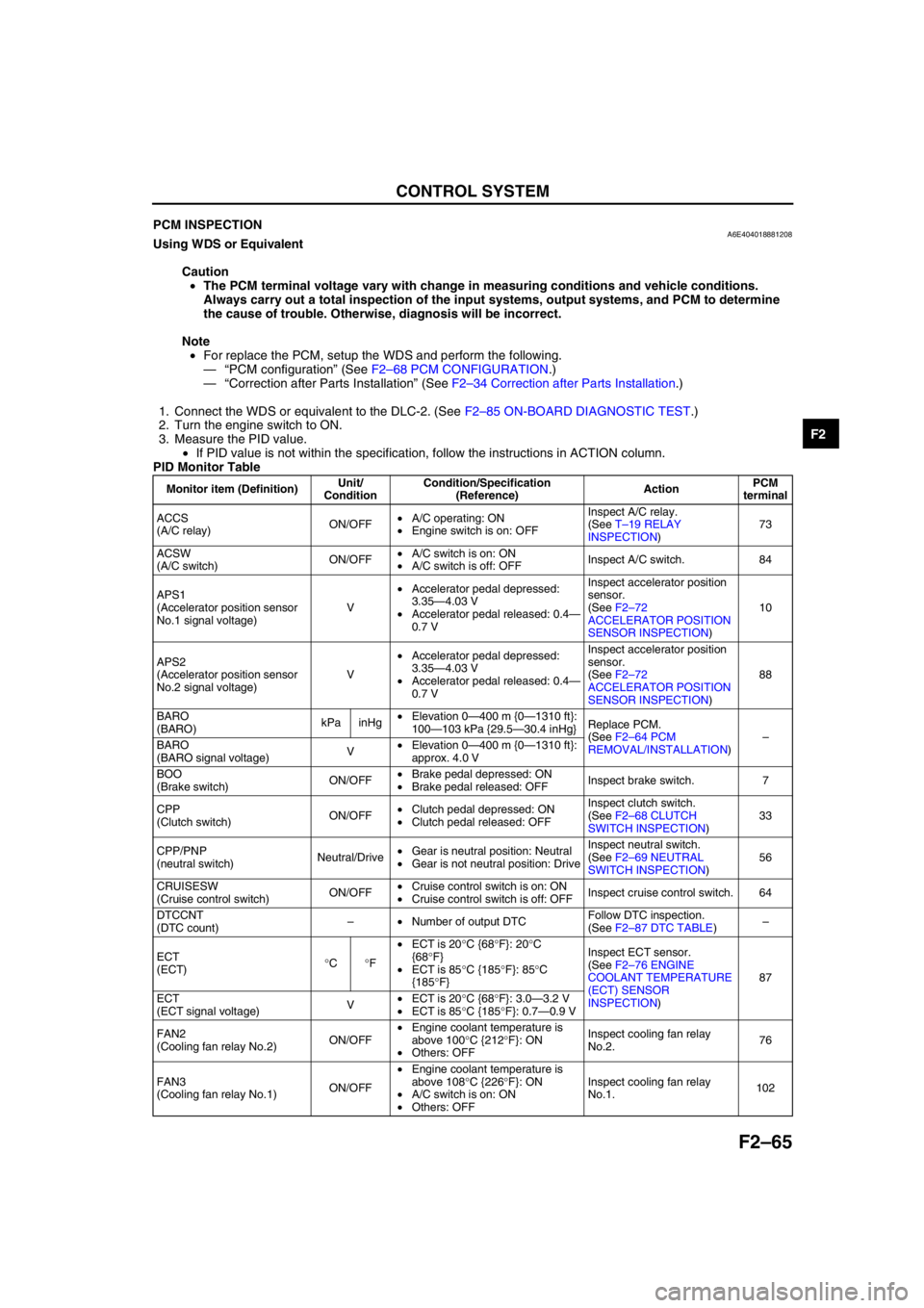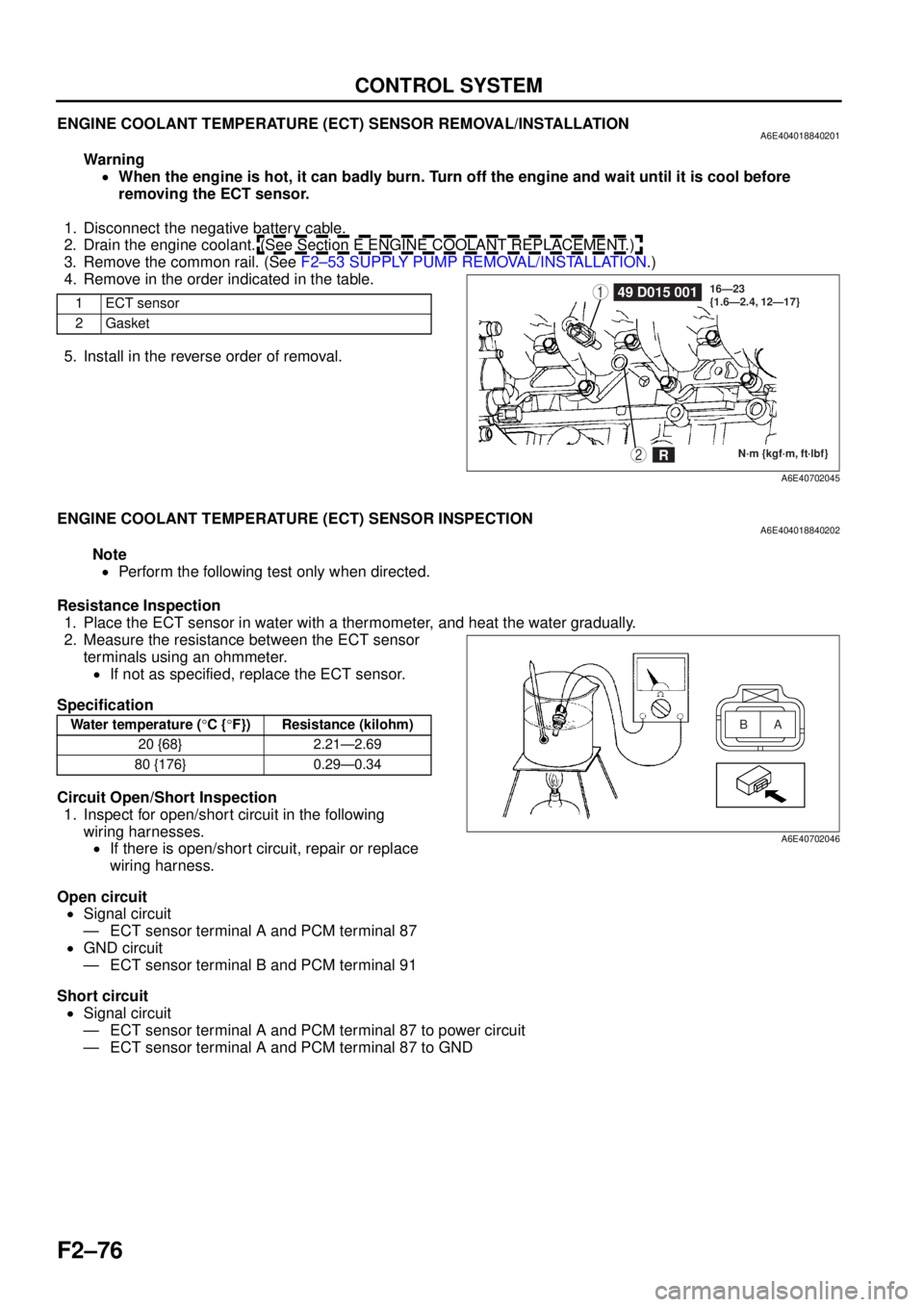coolant temperature MAZDA 6 2002 Suplement User Guide
[x] Cancel search | Manufacturer: MAZDA, Model Year: 2002, Model line: 6, Model: MAZDA 6 2002Pages: 909, PDF Size: 17.16 MB
Page 179 of 909

ON-BOARD DIAGNOSTIC
F2–27
F2
PID/DATA MONITOR AND RECORDA6E407018881204PID monitoring item table
End Of Sie
SIMULATION TESTA6E407018881205Simulation test item table
×: Applicable
Item Definition Condition/unit PCM terminal
ACCS A/C relay ON/OFF 73
ACSW A/C switch ON/OFF 84
APS1 Accelerator position sensor No.1 signal voltage V 10
APS2 Accelerator position sensor No.2 signal voltage V 88
BAROBarometric pressure kPa, inHg
-
Barometric pressure signal voltage V
BOO Brake switch ON/OFF 7
CPP Clutch switch ON/OFF 33
CPP/PNP Neutral switch Neutral/Drive 56
CRUISESW Cruise control switch ON/OFF 64
DTCCNT DTC count - -
ECTEngine coolant temperature°C, °F
87
Engine coolant temperature signal voltage V
FAN2 Cooling fan relay No.2 ON/OFF 76
FAN3 Cooling fan relay No.1 ON/OFF 102
IATIntake air temperature°C, °F
60
Intake air temperature signal voltage V
IMRC VSC solenoid valve ON/OFF 101
INGEAR In gear ON/OFF 33, 56
INJ_LRN_DIS Distance from the last injector learning Km, Mile -
MAFMass air flow amount g/s
9
Mass air flow signal voltage V
MAF_LRN_DIS Distance from the last MAF learning Km, Mile -
MAINRLY PCM control relay ON/OFF 69
MAPManifold absolute pressure kPa, inHg
36
Manifold absolute pressure signal voltage V
MIL Malfunction indicator lamp ON/OFF 71
NUMKEYS Number of keys stored in module - -
RPM Engine speed rpm 3, 29
VPWR Battery positive voltage V 27
VSS Vehicle speed km/h, mph 13, 39
Item Definition OperationTest condition
PCM
terminal
Key ON Idle
ACCS A/C relay ON or OFF××73
EGRA EGR solenoid valve (vent)Actuated by any duty value
(0—100%)××72
EGRV EGR solenoid valve (vacuum)Actuated by any duty value
(0—100%)××99
EGRV2 EGR control solenoid valve ON or OFF××77
FAN Cooling fan No.2 ON or OFF××76
FAN3 Cooling fan No.1 ON or OFF××102
GP_LMP Glow indicator light ON or OFF××97
GPC Glow plug relay ON or OFF××68
IASV Intake shutter solenoid valve (half) ON or OFF××74
IASV2 Intake shutter solenoid valve (full) ON or OFF××100
IMRC VSC solenoid valve ON or OFF××101
VBCV VBC solenoid valveActuated by any duty value
(0—100%)××67
Page 185 of 909

LOCATION INDEX
F2–33
F2
End Of Sie
1 PCM (with built-in BARO sensor and immobilizer
unit)
(SeeF2–64 PCM REMOVAL/INSTALLATION)
(SeeF2–65 PCM INSPECTION)
(SeeF2–68 PCM CONFIGURATION)
2 Clutch switch
(SeeF2–68 CLUTCH SWITCH INSPECTION)
3 Neutral switch
(SeeF2–69 NEUTRAL SWITCH INSPECTION)
4 Idle switch
(SeeF2–70 IDLE SWITCH INSPECTION)
(SeeF2–71 IDLE SWITCH ADJUSTMENT)
5 Accelerator position sensor
(SeeF2–72 ACCELERATOR POSITION SENSOR
INSPECTION)
(SeeF2–73 ACCELERATOR POSITION SENSOR
ADJUSTMENT)
6 MAF/IAT sensor
(SeeF2–74 MASS AIR FLOW (MAF)/INTAKE AIR
TEMPERATURE (IAT) SENSOR INSPECTION)
7 IAT sensor No.2
(SeeF2–75 INTAKE AIR TEMPERATURE (IAT)
SENSOR NO.2 INSPECTION)
8ECT sensor
(SeeF2–76 ENGINE COOLANT TEMPERATURE
(ECT) SENSOR REMOVAL/INSTALLATION)
(SeeF2–76 ENGINE COOLANT TEMPERATURE
(ECT) SENSOR INSPECTION)
9 Fuel temperature sensor
(SeeF2–77 FUEL TEMPERATURE SENSOR
INSPECTION)
10 Boost sensor
(SeeF2–78 BOOST SENSOR INSPECTION)
11 Fuel pressure sensor
(SeeF2–79 FUEL PRESSURE SENSOR
INSPECTION)
12 CMP sensor
(SeeF2–80 CAMSHAFT POSITION (CMP)
SENSOR REMOVAL/INSTALLATION)
(SeeF2–80 CAMSHAFT POSITION (CMP)
SENSOR INSPECTION)
13 CKP sensor
(SeeF2–81 CRANKSHAFT POSITION (CKP)
SENSOR REMOVAL/INSTALLATION)
(SeeF2–82 CRANKSHAFT POSITION (CKP)
SENSOR INSPECTION)
14 Calibration resistor
(SeeF2–83 CALIBRATION RESISTOR
INSPECTION)
15 IDM
(SeeF2–84 INJECTOR DRIVER MODULE (IDM)
INSPECTION)
Page 217 of 909

CONTROL SYSTEM
F2–65
F2
End Of SiePCM INSPECTIONA6E404018881208Using WDS or Equivalent
Caution
•The PCM terminal voltage vary with change in measuring conditions and vehicle conditions.
Always carry out a total inspection of the input systems, output systems, and PCM to determine
the cause of trouble. Otherwise, diagnosis will be incorrect.
Note
•For replace the PCM, setup the WDS and perform the following.
—“PCM configuration” (See F2–68 PCM CONFIGURATION.)
—“Correction after Parts Installation” (See F2–34 Correction after Parts Installation.)
1. Connect the WDS or equivalent to the DLC-2. (See F2–85 ON-BOARD DIAGNOSTIC TEST.)
2. Turn the engine switch to ON.
3. Measure the PID value.
•If PID value is not within the specification, follow the instructions in ACTION column.
PID Monitor Table
Monitor item (Definition)Unit/
ConditionCondition/Specification
(Reference)ActionPCM
terminal
ACCS
(A/C relay)ON/OFF•A/C operating: ON
•Engine switch is on: OFFInspect A/C relay.
(See T–19 RELAY
INSPECTION)73
ACSW
(A/C switch)ON/OFF•A/C switch is on: ON
•A/C switch is off: OFFInspect A/C switch. 84
APS1
(Accelerator position sensor
No.1 signal voltage)V•Accelerator pedal depressed:
3.35—4.03 V
•Accelerator pedal released: 0.4—
0.7 VInspect accelerator position
sensor.
(See F2–72
ACCELERATOR POSITION
SENSOR INSPECTION)10
APS2
(Accelerator position sensor
No.2 signal voltage)V•Accelerator pedal depressed:
3.35—4.03 V
•Accelerator pedal released: 0.4—
0.7 VInspect accelerator position
sensor.
(See F2–72
ACCELERATOR POSITION
SENSOR INSPECTION)88
BARO
(BARO)kPa inHg•Elevation 0—400 m {0—1310 ft}:
100—103 kPa {29.5—30.4 inHg}Replace PCM.
(See F2–64 PCM
REMOVAL/INSTALLATION)–
BARO
(BARO signal voltage)V•Elevation 0—400 m {0—1310 ft}:
approx. 4.0 V
BOO
(Brake switch)ON/OFF•Brake pedal depressed: ON
•Brake pedal released: OFFInspect brake switch. 7
CPP
(Clutch switch)ON/OFF•Clutch pedal depressed: ON
•Clutch pedal released: OFFInspect clutch switch.
(See F2–68 CLUTCH
SWITCH INSPECTION)33
CPP/PNP
(neutral switch)Neutral/Drive•Gear is neutral position: Neutral
•Gear is not neutral position: DriveInspect neutral switch.
(See F2–69 NEUTRAL
SWITCH INSPECTION)56
CRUISESW
(Cruise control switch)ON/OFF•Cruise control switch is on: ON
•Cruise control switch is off: OFFInspect cruise control switch. 64
DTCCNT
(DTC count)–•Number of output DTCFollow DTC inspection.
(See F2–87 DTC TABLE)–
ECT
(ECT)°C°F•ECT is 20°C {68°F}: 20°C
{68°F}
•ECT is 85°C {185°F}: 85°C
{185°F}Inspect ECT sensor.
(See F2–76 ENGINE
COOLANT TEMPERATURE
(ECT) SENSOR
INSPECTION)87
ECT
(ECT signal voltage)V•ECT is 20°C {68°F}: 3.0—3.2 V
•ECT is 85°C {185°F}: 0.7—0.9 V
FAN2
(Cooling fan relay No.2)ON/OFF•Engine coolant temperature is
above 100°C {212°F}: ON
•Others: OFFInspect cooling fan relay
No.2.76
FAN3
(Cooling fan relay No.1)ON/OFF•Engine coolant temperature is
above 108°C {226°F}: ON
•A/C switch is on: ON
•Others: OFFInspect cooling fan relay
No.1.102
Page 228 of 909

F2–76
CONTROL SYSTEM
ENGINE COOLANT TEMPERATURE (ECT) SENSOR REMOVAL/INSTALLATIONA6E404018840201
Warning•When the engine is hot, it can badly burn. Turn off the engine and wait until it is cool before
removing the ECT sensor.
1. Disconnect the negative battery cable.
2. Drain the engine coolant. (See Section E ENGINE COOLANT REPLACEMENT.)
3. Remove the common rail. (See F2–53 SUPPLY PUMP REMOVAL/INSTALLATION .)
4. Remove in the order indicated in the table.
5. Install in the reverse order of removal.
End Of Sie
ENGINE COOLANT TEMPERATURE (ECT) SENSOR INSPECTIONA6E404018840202
Note
• Perform the following test only when directed.
Resistance Inspection 1. Place the ECT sensor in water with a thermometer, and heat the water gradually.
2. Measure the resistance between the ECT sensor terminals using an ohmmeter.
• If not as specified, replace the ECT sensor.
Specification
Circuit Open/Short Inspection 1. Inspect for open/short circuit in the following
wiring harnesses.• If there is open/short circuit, repair or replace
wiring harness.
Open circuit • Signal circuit
— ECT sensor terminal A and PCM terminal 87
• GND circuit
— ECT sensor terminal B and PCM terminal 91
Short circuit • Signal circuit
— ECT sensor terminal A and PCM terminal 87 to power circuit
— ECT sensor terminal A and PCM terminal 87 to GND
End Of Sie
1ECT sensor
2Gasket149 D015 001
N·m {kgf·m, ft·lbf}
16—23
{1.6—2.4, 12—17}2R
A6E40702045
Water temperature (
°C { °F}) Resistance (kilohm)
20 {68} 2.21—2.69
80 {176} 0.29—0.34A
B
A6E40702046
Page 263 of 909

ON-BOARD DIAGNOSTIC
F2–111
F2
DTC P0117A6E407001082214
Diagnostic procedure
DTC P0117 ECT sensor circuit low input
DETECTION
CONDITION•PCM monitors input voltage from ECT sensor while engine is running. If input voltage from ECT sensor is
below 0.1 V, PCM determines ECT sensor circuit low input.
POSSIBLE
CAUSE•ECT sensor malfunction
•Connector or terminal malfunction
•Short to GND in wiring between ECT sensor terminal A and PCM terminal 87
•ECT sensor signal and GND circuits short each other
•PCM malfunction
ECT SENSOR
A
B
562
546287
91
B
APCM
91
87 ECT SENSOR
HARNESS SIDE CONNECTORPCM
HARNESS SIDE CONNECTOR
STEP INSPECTION ACTION
1PERFORM DTC CONFIRMATION PROCEDURE
•Perform “DTC Confirmation Procedure”.
(See F2–85 DTC CONFIRMATION
PROCEDURE)
•Is same DTC present during KOEO or KOER
self-test?Yes Go to next step.
No Intermittent concern exists. Go to “Intermittent Concern
Troubleshooting”.
(See F2–227 INTERMITTENT CONCERN
TROUBLESHOOTING)
2INSPECT POOR CONNECTION OF ECT
SENSOR CONNECTOR
•Turn engine switch to OFF.
•Inspect for poor connection (damaged, pulled-
out terminals, corrosion, etc.).
•Is there any malfunction?Yes Repair or replace suspected terminal, go to Step 7.
No Go to next step.
3CLASSIFY ECT SENSOR MALFUNCTION OR
HARNESS MALFUNCTION
•Turn engine switch to ON (Engine OFF).
•Disconnect ECT sensor connector.
•Access ECT PID using WDS or equivalent.
•Is ECT PID below 0.1 V?Yes Go to next step.
No Replace ECT sensor, go to Step 7.
(See F2–76 ENGINE COOLANT TEMPERATURE (ECT)
SENSOR REMOVAL/INSTALLATION)
4INSPECT ECT SENSOR SIGNAL CIRCUIT FOR
SHORT TO GND
•Turn engine switch to OFF.
•Inspect continuity between ECT sensor
terminal A and body GND.
•Is there continuity?Yes Repair or replace harness for short to GND, go to Step 7.
No Go to next step.
Page 265 of 909

ON-BOARD DIAGNOSTIC
F2–113
F2
DTC P0118A6E407001082215
Diagnostic procedure
DTC P0118 ECT sensor circuit high input
DETECTION
CONDITION•PCM monitors input voltage from ECT sensor while engine is running. If input voltage from ECT sensor is
above 5.0 V, PCM determines ECT sensor circuit high input.
POSSIBLE
CAUSE•ECT sensor malfunction
•Connector or terminal malfunction
•Short to power circuit in wiring between ECT sensor terminal A and PCM terminal 87
•Open circuit in wiring between ECT sensor terminal A and PCM terminal 87
•Open circuit in wiring between ECT sensor terminal B and PCM terminal 91
•PCM malfunction
STEP INSPECTION ACTION
1PERFORM DTC CONFIRMATION PROCEDURE
•Perform “DTC Confirmation Procedure”.
(See F2–85 DTC CONFIRMATION
PROCEDURE)
•Is same DTC present during KOEO or KOER
self-test?Yes Go to next step.
No Intermittent concern exists. Go to “Intermittent Concern
Troubleshooting”.
(See F2–227 INTERMITTENT CONCERN
TROUBLESHOOTING)
2INSPECT POOR CONNECTION OF ECT
SENSOR CONNECTOR
•Turn engine switch to OFF.
•Inspect for poor connection (damaged, pulled-
out terminals, corrosion, etc.).
•Is there any malfunction?Yes Repair or replace suspected terminal, go to Step 7.
No Go to next step.
3CLASSIFY ECT SENSOR MALFUNCTION OR
HARNESS MALFUNCTION
•Turn engine switch to ON (Engine OFF).
•Connect jumper wire between ECT sensor
connector terminals.
•Access ECT PID using WDS or equivalent.
•Is ECT PID below 1.0 V?Yes Replace ECT sensor, go to Step 7.
(See F2–76 ENGINE COOLANT TEMPERATURE (ECT)
SENSOR REMOVAL/INSTALLATION)
No Go to next step.
562
5462
ECT SENSOR
A
BPCM
87
91
B
A
9187 ECT SENSOR
HARNESS SIDE CONNECTORPCM
HARNESS SIDE CONNECTOR
Page 351 of 909

TROUBLESHOOTING
F2–199
F2
NO.13 KNOCKING/PINGINGA6E408018881215
Diagnostic Procedure
13 KNOCKING/PINGING
DESCRIPTION•Excessive shrilly knocking sound from engine.
POSSIBLE
CAUSE•Poor fuel quality
•Air leakage from intake-air system
•Intake-air system restriction or clogging
•Variable swirl control (VSC) system malfunction
•Variable boost control (VBC) system malfunction
•Intake shutter valve stuck close
•VSC valve stuck close
•Glow system malfunction
•Low engine compression
•Improper valve timing
•Low coolant temperature
•Incorrect fuel injection timing
•Erratic signal from CKP sensor
•Erratic signal from CMP sensor
•ECT sensor or related circuit malfunction
•MAF/IAT sensor or related circuit malfunction
•IAT sensor No.2 or related circuit malfunction
•Boost sensor or related malfunction
•Fuel pressure sensor or related circuit malfunction
•Accelerator position sensor or related circuit malfunction
•Excessive fuel pressure
•Fuel return line clogging or restriction
•EGR system malfunction
•Exhaust system and/or catalyst converter restriction
•Turbocharger malfunction
•Charge air cooler malfunction
•Suction control valve malfunction (built-in supply pump)
Warning
The following troubleshooting flow chart contains the fuel system diagnosis and repair
procedures. Read the following warnings before performing the fuel system services:
•Fuel vapor is hazardous. It can easily ignite, causing serious injury and damage. Always keep
sparks and flames away from fuel.
•Fuel line spills and leakage are dangerous. Fuel can ignite and cause serious injury or death
and damage. Fuel can also irritate skin and eyes. To prevent this, always complete “BEFORE
REPAIR PROCEDURE” and “AFTER REPAIR PROCEDURE” described in this manual.
STEP INSPECTION RESULTS ACTION
1 Does engine run cold? Yes Go to symptom troubleshooting “NO.18 COOLING
SYSTEM CONCERNS—RUNS COLD”.
No Go to next step.
2 Inspect for following:
•Fuel quality (e.g.: including water
contamination, winter/summer blend)
•Fuel return line clogging and/or restriction
•Intake-air system restriction or clogging
•Exhaust system and/or catalyst converter
restriction or clogging
•Charge air cooler condition (restriction or
damaged)
Are all items okay?Yes Go to next step.
No Service as necessary.
Repeat Step 2.
3 Connect WDS or equivalent to DLC-2.
Access ECT PID.
Verify ECT PID is above 80 °C {176 °F}?Yes Go to next step.
No Inspect ECT PID.
Page 357 of 909

TROUBLESHOOTING
F2–205
F2
NO.15 EMISSION COMPLIANCEA6E408018881217
Diagnostic Procedure
15 EMISSION COMPLIANCE
DESCRIPTION•Fails emissions test.
POSSIBLE
CAUSE•Poor fuel quality
•Vacuum leakage
•Air leakage from intake-air system
•Intake-air system restriction or clogging
•Variable swirl control (VSC) system malfunction
•Variable boost control (VBC) system malfunction
•Intake shutter valve stuck close
•VSC valve stuck close
•Turbocharger malfunction
•Guide blade valve malfunction
•Charge air cooler malfunction
•Glow system malfunction
•EGR system malfunction
•EGR water cooler malfunction
•Low coolant temperature
•Engine overheating
•Inadequate fuel pressure
•Fuel pressure limiter malfunction (built-in common rail)
•Suction control valve inspection (built-in supply pump)
•ECT sensor or related circuit malfunction
•MAF/IAT sensor related circuit malfunction
•IAT sensor No.2 or related circuit malfunction
•Fuel pressure sensor or related circuit malfunction
•Incorrect adjustment accelerator position sensor and/or idle switch
•Accelerator position sensor or related circuit malfunction
•Idle switch or related circuit malfunction
•Fuel line rclogging or restriction
•Supply pump malfunction
•Fuel injector malfunction
•Incorrect fuel injection timing
•Incorrect idle speed
•Erratic signal from CKP sensor
•Erratic signal from CMP sensor
•Boost sensor or related circuit malfunction
•Neutral switch or related circuit malfunction
•VSS or related circuit malfunction
•Low engine compression
•Improper valve timing
•Base engine malfunction
•Exhaust system and/or catalyst converter restriction
•Catalyst converter malfunction
•IDM or related circuit malfunction
Warning
The following troubleshooting flow chart contains the fuel system diagnosis and repair
procedures. Read the following warnings before performing the fuel system services:
•Fuel vapor is hazardous. It can easily ignite, causing serious injury and damage. Always keep
sparks and flames away from fuel.
•Fuel line spills and leakage are dangerous. Fuel can ignite and cause serious injury or death
and damage. Fuel can also irritate skin and eyes. To prevent this, always complete “BEFORE
REPAIR PROCEDURE” and “AFTER REPAIR PROCEDURE” described in this manual.
STEP INSPECTION RESULTS ACTION
1 Is engine overheating? Yes Go to symptom troubleshooting “NO.17 COOLING
SYSTEM CONCERNS—OVERHEATING”.
No Go to next step.
2 Does engine run cold? Yes Go to symptom troubleshooting “NO.18 COOLING
SYSTEM CONCERNS—RUNS COLD”.
No Go to next step.
Page 362 of 909

F2–210
TROUBLESHOOTING
End Of SieNO.17 COOLING SYSTEM CONCERNS-OVERHEATINGA6E408018881219
Diagnostic Procedure
17
COOLING SYSTEM CONCERNS-OVERHEATING
DESCRIPTION•Engine runs at higher than normal temperature/overheats.
POSSIBLE
CAUSE•Cooling fan No.2 malfunction
•Cooling fan No.1 malfunction
•Low drive belt tension
•Drive belt damage
•Improper coolant level
•Thermostat malfunction
•Radiator clogging
•Improper water/anti-freeze mixture
•Improper or damaged radiator cap
•Radiator hose damage
•Coolant leakage (engine internal, turbocharger, external)
•A/C system malfunction
•EGR system malfunction
•Coolant heater system malfunction
STEP INSPECTION RESULTS ACTION
1 Inspect following:
•Engine coolant level
•Coolant leakage (around heater unit in
passenger compartment, coolant hoses and/
or radiator, and around coolant heater unit.)
•Water and anti-freeze mixture
•Radiator condition
•Collapsed or restricted radiator hoses
•Radiator pressure cap
•Drive belt tension
•Drive belt
•Fan rotational direction
Are all items okay?Yes Go to next step.
No Service as necessary.
Repeat Step 1.
2 Perform self-test function using WDS or
equivalent.
Turn engine switch to ON.
Retrieve any DTC.
Is DTC displayed?YesDTC is displayed:
Go to appropriate DTC test.
Communication error message is displayed:
Inspect for following:
•Open circuit between PCM control relay and PCM
terminal 53 or 79
•Open circuit PCM control relay and PCM terminal
69
•PCM control relay stuck open
•Open or poor GND circuit (PCM terminal 65, 85,
103 or 104)
•Poor connection vehicle body GND
NoNo DTC is displayed:
Go to next step.
Page 364 of 909

F2–212
TROUBLESHOOTING
NO.18 COOLING SYSTEM CONCERNS-RUNS COLDA6E408018881220
Diagnostic Procedure
End Of Sie
18 COOLING SYSTEM CONCERNS-RUNS COLD
DESCRIPTION•Engine takes excessive period for reaching normal operating temperature.
POSSIBLE
CAUSE•Thermostat malfunction
•Cooling fan No.2 system malfunction
•Cooling fan No.1 system malfunction
•Coolant heater system malfunction
STEP INSPECTION RESULTS ACTION
1 Is customer complaint “Lack of passenger
compartment heat”?Yes Inspect A/C heater system.
No Go to next step.
2 Does engine speed continue at fast idle? Yes Go to symptom troubleshooting “NO.7 SLOW
RETURN TO IDLE”.
No Go to next step.
3 Connect WDS or equivalent to DLC-2.
Access ECT PID.
Inspect for both ECT PID and temperature
gauge on instrument cluster readings.
Is ECT PID same as temperature gauge
reading?Yes Go to next step.
No If temperature gauge on instrument cluster indicates
normal range but ECT PID is not same as temperature
gauge reading, inspect ECT sensor.
If temperature gauge on instrument cluster indicates
cold range but ECT PID is normal, inspect
temperature gauge and heat gauge unit.
4 Remove thermostat and inspect operation.
(See E–9 THERMOSTAT REMOVAL/
INSTALLATION)
(See E–10 THERMOSTAT INSPECTION)
Is thermostat okay?Yes Go to next step.
No Replace thermostat.
5 Inspect cooling fan No.1 and cooling fan No.2
operations.
If both or either fan operate normally, inspect for
following:
•Cooling fan relay No.2 is stuck closed
•Short to GND between cooling fan relay No.2
and PCM terminal 76
•Circuit between cooling fan relay No.2 and
fan motor short to battery supply line
•Cooling fan relay No.1 is stuck closed
•Short to GND between cooling fan relay No.1
and PCM terminal 102
•Circuit between cooling fan relay No.1 and
fan motor short to battery supply line
•Short to GND between A/C switch and PCM
terminal 84
Are all circuits okay?Yes Perform coolant heater system inspection.
Repair or replace malfunctioning part according to
coolant heater system operation results.
No Repair or replace as necessary.
6 Verify test results.
•If okay, return to diagnostic index to service any additional symptoms.
•If malfunction remains, replace PCM. (See F2–64 PCM REMOVAL/INSTALLATION)